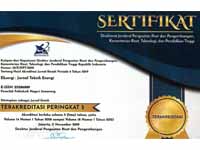Design and Analysis of Venturi Microbubble Generator Using Computational Fluid Dynamics
DOI:
https://doi.org/10.32497/eksergi.v19i2.4305Keywords:
Aerator, CFD Simulation, Microbubble generator, VenturiAbstract
The necessity for dissolved oxygen in water is crucial for the survival and growth of aquatic organisms, particularly tilapia. Seventy-five percent of tilapia will die if there is insufficient dissolved oxygen in the water. This work seeks to develop a venturi bubble-generating technique to combat the scarcity of dissolved oxygen in the water. A floating pump with a capacity of 12 m3/hour was selected as the medium for distributing water and generating vacuum pressure to draw in air for mixing with the water flow in the venturi. Ansys Fluent was used to model piping and venturi systems. The piping system was modeled with a single-phase (water) flow at a steady state, whereas the flow in the venturi was modeled with a multiphase (air and water) flow under transient situations. The simulation findings revealed that the pressure drop at the 90-degree elbow was much greater (27.17 kPa) than that at the 45-degree elbow (16.53 kPa). A 1-inch input diameter venturi produced bubbles with an average diameter of 105 µm, whereas a ½ inch venturi bubble generator produced bubbles with an average diameter of 83 µm. Owing to the numerous advantages of adopting a six-outlet piping system with a ½ inch venturi, this design is recommended for floating pumps with a capacity of 12 m3/h.References
V. A. Prakoso and Y. J. Chang, “Pengaruh Hipoksia terhadap Konsumsi Oksigen pada Benih Ikan Nila (Oreochromis niloticus),” Oseanologi dan Limnol. di Indones., vol. 3, pp. 165”“171, 2018, doi: 10.14203/oldi.2018.v3i2.169.
M. Abdel-Tawwab, A. E. Hagras, H. A. M. Elbaghdady, and M. N. Monier, “Effects of dissolved oxygen and fish size on Nile tilapia, Oreochromis niloticus (L.): growth performance, wholebody composition, and innate immunity,” Aquacult Int, vol. 23, pp. 1261”“1274, 2015, doi: 10.1007/s10499-015-9882-y.
F. A. Huntingford et al., “Coping strategies in a strongly schooling fish, the common carp Cyprinus carpio,” J. Fish Biol., vol. 76, pp. 1576”“1591, 2010, doi: 10.1111/j.1095-8649.2010.02582.x.
I. Prasetyaningsari, A. Setiawan, and A. A. Setiawan, “Design optimization of solar powered aeration system for fish pond in Sleman Regency, Yogyakarta by HOMER software,” Energy Procedia, vol. 32, pp. 90”“98, 2013, doi: 10.1016/j.egypro.2013.05.012.
S. Zhou, M. Liu, B. Chen, L. Sun, and H. Lu, “Microbubble- and nanobubble-aeration for upgrading conventional activated sludge process: A review,” Bioresour. Technol., vol. 362, p. 127826, 2022, doi: 10.1016/j.biortech.2022.127826.
E. De Oro Ochoa, M. Carmona GarcÃa, N. Durango Padilla, and A. MartÃnez Remolina, “Design and experimental evaluation of a Venturi and Venturi-Vortex microbubble aeration system,” Heliyon, vol. 8, p. e11096, 2022, doi: 10.1016/j.heliyon.2022.e11096.
A. Agarwal, W. J. Ng, and Y. Liu, “Principle and applications of microbubble and nanobubble technology for water treatment,” Chemosphere, vol. 84, no. 9, pp. 1175”“1180, Aug. 2011, doi: 10.1016/j.chemosphere.2011.05.054.
M. Liu, T. Li, Z. Wang, T. Radu, H. Jiang, and L. Wang, “Effect of aeration on water quality and sediment humus in rural black-odorous water,” J. Environ. Manage., vol. 320, p. 115867, 2022, doi: 10.1016/j.jenvman.2022.115867.
A. Endo et al., “DO-increasing effects of a microscopic bubble generating system in a fish farm,” Mar. Pollut. Bull., vol. 57, pp. 78”“85, 2008, doi: 10.1016/j.marpolbul.2007.10.014.
B. Choi, T.-Y. Jeong, and S. Lee, “Application of jetventurimixer for developing low-energy-demand and highly efficient aeration process of wastewater treatment,” Heliyon, vol. 8, p. e11096, 2022, doi: 10.1016/j.heliyon.2022.e11096.
A. Basso, F. A. Hamad, and P. Ganesan, “Effects of the geometrical configuration of air”“water mixer on the size and distribution of microbubbles in aeration systems,” Asia-Pacific J. Chem. Eng., vol. 13, pp. 1”“11, 2018, doi: 10.1002/apj.2259.
M. Wu, S. Yuan, H. Song, and X. Li, “Micro-nano bubbles production using a swirling-type venturi bubble generator,” Chem. Eng. Process. - Process Intensif., vol. 170, p. 108697, 2022, doi: 10.1016/j.cep.2021.108697.
C. H. Lee, H. Choi, D.-W. Jerng, D. E. Kim, S. Wongwises, and H. S. Ahn, “Experimental investigation of microbubble generation in the venturi nozzle,” Int. J. Heat Mass Transf., vol. 136, pp. 1127”“1138, 2019, doi: 10.1016/j.ijheatmasstransfer.2019.03.040.
K. Sakamatapan, M. Mesgarpour, O. Mahian, H. S. Ahn, and S. Wongwises, “Experimental investigation of the microbubble generation using a venturi-type bubble generator,” Case Stud. Therm. Eng., vol. 27, p. 101238, 2021, doi: 10.1016/j.csite.2021.101238.
J. Huang et al., “A review on bubble generation and transportation in Venturi-type bubble generators,” Exp. Comput. Multiph. Flow, vol. 2, pp. 123”“134, 2020, doi: 10.1007/s42757-022-0132-z.
H. Luo and H. F. Svendsen, “Theoretical model for drop and bubble breakup in turbulent dispersions,” AIChE J., vol. 42, pp. 1225”“1233, 1996, doi: 10.1002/aic.690420505.
F. Lehr, M. Millies, and D. Mewes, “Bubble-Size distributions and flow fields in bubble columns,” AIChE J., vol. 48, pp. 2426”“2442, 2002, doi: 10.1002/aic.690481103.
N. Dutta, P. Kopparthi, A. K. Mukherjee, N. Nirmalkar, and G. Boczkaj, “Novel strategies to enhance hydrodynamic cavitation in a circular venturi using RANS numerical simulations,” Water Res., vol. 204, p. 117559, 2021, doi: 10.1016/j.watres.2021.117559.
Downloads
Published
Issue
Section
License
Authors who publish with this journal agree to the following terms:Authors retain copyright and grant the journal right of first publication with the work simultaneously licensed under a Creative Commons Attribution License that allows others to share the work with an acknowledgement of the work's authorship and initial publication in this journal.
Authors are able to enter into separate, additional contractual arrangements for the non-exclusive distribution of the journal's published version of the work (e.g., post it to an institutional repository or publish it in a book), with an acknowledgement of its initial publication in this journal.
Authors are permitted and encouraged to post their work online (e.g., in institutional repositories or on their website) prior to and during the submission process, as it can lead to productive exchanges, as well as earlier and greater citation of published work (See The Effect of Open Access).






